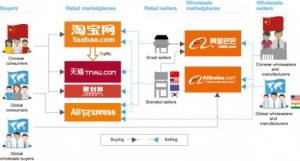Alibaba: Taking Advantage of Network Effects
Direct benefit effects occur in economic transactions in markets where the behavior of consumers lines up with that of suppliers. They create positive externalities in which one individuals’ decision to use a service directly increases the value of that service to other consumers (and/or suppliers). This is exactly the case with the e-commerce giant, Alibaba, which has pioneered the online manufacturing market through both its IPO size and importance to global manufacturers and enterprises.
Alibaba is a site that empowers smaller businesses to compete with large-cap branding and retailer giants giants by effectively creating supply chain links to minimize costs and production through economies of scale. For example, if I were to run a business in the United States that sold custom fabricated dress shirts, I, as the business-owner, could use Alibaba as a sort of Craigslist intermediary. In listing the specs and sizes of the types of dress shirts that I wanted, I could post an ad on Alibaba where suppliers would compete for my contract where they would be sorted by region, price, and feedback quality. This technologically economic interface has directly led to market effects, which the company has explicitly stated in its SEC report. The graphic bellow is an effective depiction of the relationships between parties in Alibaba:
When we delve further into Alibaba’s business model, we see that consumers and buyers represent a multitude of different parties—they can range anywhere from Asian manufacturing companies to big-box retailers to mom-and-pop shops across the globe. This interface creates a positive externality for both buyers and sellers, which we defined earlier as a positive effect from a transaction that affects a third party not reflected in the initial transaction. We can separate parties into two groups: buyers and sellers. The presence of more buyers and sellers on the site creates a positive-feedback network effect, in which an increase of the quantities of either buyers or sellers increases the value of Alibaba–this is the positive externality, as one transaction leads to the benefit of other consumers or sellers in the form of low-price, high-quality products.
When more sellers join the site, this gives the buying party more variety. As a buyer, my economic (not necessarily financial) payoff would increase as the number of sellers on the site increases because I would have more choices to pick from, and they would likely come at lower costs. As other buyers jump into Alibaba’s marketplace, sellers look to exploit the new opportunity for profit and are therefore prompted to join in the market as well. This positive feedback loop manifests itself as more buyers jump into the market. The self-fulfilling prophecy drives a continual increase in payoff as more and more parties begin to adopt Alibaba as an interface for organizing supply chains with different businesses across the globe.
Sources:
http://dealbook.nytimes.com/2013/04/25/why-alibaba-could-be-chinas-next-100-billion-i-p-o/?_r=0

